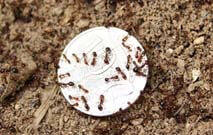The horrors of red imported fire ants
For an insect that’s only 2-6mm long the red imported fire ant (RIFA) is the star of its own horror story.

Imagine putting your baby on a rug in the backyard and having its hands badly bitten. And what about a man who takes a nap on an ant hill and ends up in hospital in excruciating pain.
At best the fire ant sting burns like you have been set on fire, and at worst you could have an allergic reaction that could threaten your life.
A native of South America, RIFA is one of the world’s worst invasive ant species and is widespread across south east USA. On average 14 million people are stung each year with 25,000 people requiring medical attention.
 Attacks on immobile people in nursing homes have even resulted in deaths: strategies are in place for nursing homes and day care centers where the most vulnerable people are at risk of attack.
Attacks on immobile people in nursing homes have even resulted in deaths: strategies are in place for nursing homes and day care centers where the most vulnerable people are at risk of attack.
As well as the human health issues there are also economic, environmental, infrastructure and agricultural issues.
RIFA are known to:
- attack livestock and small animals, including pets
- eat reptile and ground nesting bird eggs
- eat the young tender growth of a range of crops such as citrus, cucumber, eggplant and sweet potato plants, reducing production
mounds can stop harvest equipment - nest under footpaths, foundations and verandahs, causing them to collapse
- disable electricity boxes
- make a family picnic a thing of the past.
Since fire ants were first discovered in south east Queensland in 2001, the Queensland Government has been delivering the National Red Imported Fire Ant Eradication Program in south east Queensland on behalf of the Australian and all state and territory governments.
RIFA are thought to have reached Brisbane by hitch-hiking on an Argentinian shipping container.
While control and eradication measures cost millions of dollars each year, the expenditure is small when compared to the potential long term cost of fire ants to Australia.
 The cost of managing fire ants as an established species in Australia would be significant and would have long term consequences for many industries such as development, construction, tourism, agriculture, the environment, health, infrastructure and social amenity.
The cost of managing fire ants as an established species in Australia would be significant and would have long term consequences for many industries such as development, construction, tourism, agriculture, the environment, health, infrastructure and social amenity.
If not contained, Australia could face similar impacts as the US, which spends an estimated $US7 billion annually on damage repair, medical costs and control measures.
The rest of Australia has not been affected by the Queensland incursion due to the diligence of the Queensland Government and biosecurity legislation in place to restrict the movement of high risk materials that could carry RIFA into the other states and territories.
There are procedures that must be followed when moving high risk materials (or fire ant carriers) such as soil, mulch, and turf from the infested areas, including potted plants in potting mix.
Movement of hay and straw is also an issue as this is a known pathway for movement.
A biosecurity instrument permit may be required prior to moving soil from or within one of the three fire ant biosecurity zones.
If you live in or are visiting south east Queensland where a fire ant biosecurity zone is in place, please don’t take anything that could carry this terrible pest out of the infested area. Play your part and keep us all safe.
For more information, contact Biosecurity Queensland on 13 25 23 or visit www.daf.qld.gov.au/fireants

